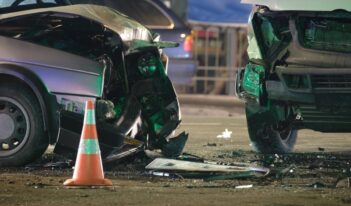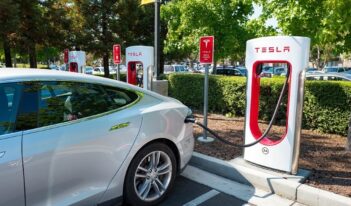
Transportation Department proposes rule mandating vehicle-to-vehicle communication technology.
Driving home from work late at night, you notice that the roads are emptier than usual. But as you pause at a street corner, another car comes careening down the block and runs a red light through the intersection. Unperturbed, you turn off the notification that your vehicle provided moments before using its advanced communication technology: “Warning: incoming vehicle with disengaged brake.”
In a world with widespread vehicle-to-vehicle communication (V2V), avoiding potential accidents like the one above would become easier for drivers, preventing countless crashes and deaths. And with a recently proposed rule from the U.S. Department of Transportation that aims to increase the rate of V2V technology adoption, the auto industry is closer to widespread adoption of V2V than ever before.
V2V communications—a method of sharing data such as vehicle speed and brake function over short-range radio—can detect potential and imminent car accidents and warn drivers far sooner than the in-car sensor and camera technologies available today. With its proposed rule, the Transportation Department mandates that auto manufacturers equip all new passenger cars and light trucks with technology capable of sending and receiving basic messages. If the proposed rule is finalized in 2019, as currently expected by the National Highway Traffic Safety Agency (NHTSA), all vehicles subject to regulation would be required to comply by 2023 after a three-year phase-in period.
As support for the proposed rule, which is estimated to cost several billion dollars, the Transportation Department emphasizes the potential safety benefits of widespread V2V adoption. Of the approximately 5.5 million crashes that occur annually, the Department notes that 3.8 million are multi-vehicle crashes that V2V technology could mitigate or prevent. And, critically, because both vehicles in an accident must be able to communicate with each other, realizing these safety benefits will require that V2V is not only widely adopted, but also adopted seamlessly across different manufacturers. Ensuring that V2V technology overcomes these hurdles and realizes its potential, according to NHTSA, requires government action.
Thus far, much of the popular media coverage of V2V communications has focused on its application to self-driving cars. And although the Transportation Department’s analysis does not hinge on this particular application, NHTSA does note that encouraging V2V communications “may be necessary to realize the full potential of vehicle automation.”
The advent of innovations like self-driving cars and V2V technology may come as a surprise to many Americans, but automobile manufacturers in the United States as well as abroad have been testing the feasibility of these technologies for over a decade. In terms of V2V alone, U.S. manufacturers such as General Motors and Ford have already demonstrated their vehicles’ capabilities. Ford notably highlighted its V2V technology using “daredevil” drivers at a trade show in 2014, and General Motors announced in 2014 that it would include V2V in certain 2017 model year vehicles.
According to Harry Lightsey, executive director for public policy at General Motors, V2V has reportedly advanced to the point of being “at the 1-yard line” and is “ready to be deployed.”
Critics of the proposed rule do not contest its safety benefits, but instead question whether V2V should be able to use the part of the radio spectrum that it is slated to use. The National Cable and Telecommunications Association, which represents companies such as Comcast and Fox, is urging the Federal Communications Commission to reconsider its allocation of a particular band of radio spectrum solely for V2V use. Although some auto manufacturers argue that setting aside spectrum for V2V will protect against harmful interference, sectors dependent on Wi-Fi claim that they will require at least part of the allocated spectrum band to advance next-generation Wi-Fi.
Apart from radio spectrum conflicts, security experts also point to vehicles’ increased vulnerability to potential hacking. In the past, hackers have successfully taken control of cars remotely—changing radio stations, disabling brakes, and even hijacking the steering wheel. In one instance, a pair of hackers remotely killed the engine on a Jeep on a highway and drove it into a ditch, exposing a potential security flaw that led to the recall of 1.4 million Fiat Chrysler vehicles.
Although some hackers and security experts are working with auto manufacturers to spot and patch security flaws, less scrupulous cybercriminals will undoubtedly attempt to use security vulnerabilities to wreak havoc.
In response to these concerns, the Transportation Department acknowledges that security flaws may exist, and seeks comments on potential threats and risks to V2V equipment. Yet, it has largely passed responsibility for preventing hacking on to manufacturers, stating that it “expects manufacturers to ensure that vehicle systems take appropriate steps to the maximum extent possible, even when an attack may be successful.”
The proposed rule will remain open for public comment until April 12, 2017.



